When it comes to jewelry, colored stones can be a hit or miss for jewelry enthusiasts. Some prefer the classic clear diamond’s sparkle, as it can be worn with anything. Those who would choose colored stones may go for the classic choices. Many jewelry buyers usually choose rubies, emeralds, and sapphires as their first choice. On the other hand, those from the younger market may prefer the rose quartz, Yet a budding market now appears to be opting for the rich and mysterious vibe of purple gemstones.
Top Purple Gemstones In The Industry
If you are interested in exploring what gems can fit this intriguing color, then it may be good to understand all about precious purple stones. Unlike other types of gems, purple ones may not be as prolific, but they are just as valuable as some favorite diamonds.
Understand what that purple hue stands for, what its meaning is, and what the different shades are in the market. Check out which of these precious stones’ purple tinge and insightful meaning resonate with you.
Purple: The Color of Creativity
When thinking about the meaning of colors, purple usually gets associated with anything of royalty. Used to be the color combination of yellow and purple has exuded the colors of royalty. Yellow represents boldness and confidence, due to its bright and stark hue. Purple combines the silent strength of blue and the fire of red.
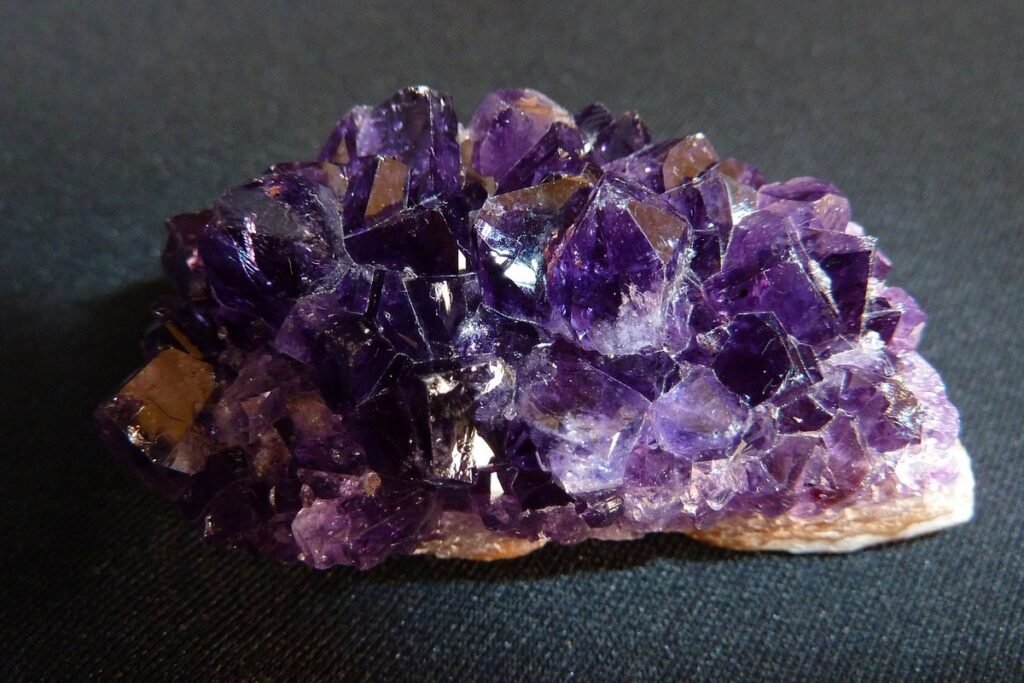
Thus, purple often becomes associated with power and grandeur, especially for the warmer shades of purple. Cooler shades, which include a lot of blue tinge, are often representative of wisdom, dignity, and mystery.
In some cases, purple can also be seen as a spiritual color. This may be due partly to its creative spirit. Compared to other colors, purple does not always easily occur in nature. When plants or stones have a naturally occurring purple tinge to them, they are treated as sacred and rare. This makes the color purple even more valuable.
The regal color
There’s a reason why purple has long been associated with wealth and power. History holds the records of purple often only being in the hands and clothes of the wealthy.
Since the color purple does not often naturally occur, it requires the extra step of dyeing in the case of clothes. Back in the time of Queen Elizabeth I, purple became the royal family’s color. On the logistical side, the Tyrian purple dye was so costly and rare because of its production process. It took 9,000 mollusks to create a gram of the pigment. This kind of dye could not be afforded by anyone else except for the royals.
On the personal side, it appears that Queen Elizabeth I had become so fond of the purple herself. The Sumptuary Laws then dictated that non-royals cannot wear the color, further distinguishing the color in value. It has become an exclusive nature that connoted one’s social status and monetary wealth.
Purple in gemstones
In jewelry, the purple color reflects the long-held ideals of the hue. It stands for spirituality, wisdom, dignity, and passion. Depending on which gemstone you wear, purple can also be associated with fantasy and mystery. A more elegant and rich tone amplifies its regal quality, while a lighter shade hints at a more fun and creative side.
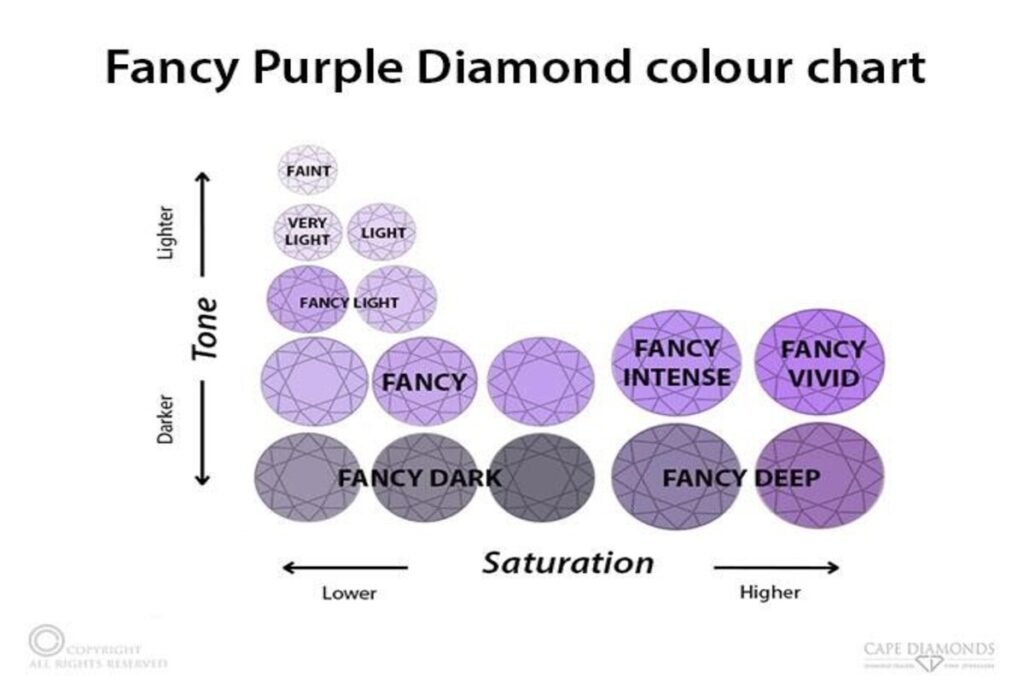
If you are wondering, “What jewelry stone is purple?” then you would be happy to know that there are a number of naturally-occurring stones bearing this shade. It’s a matter of knowing the shade and exact stone you prefer on your ring.
Purple Gemstones: Which One Fits Your Style?
If you have your eyes set on a purple gemstone, you may be wondering if the only way to get one is through artificially-colored diamonds. While purple diamonds exist, there are also a number of naturally-occurring stones that have a purple shade. In fact, many well-known gemstones have a purple variant that you may not have known about.
If you are asking, “What is a purple precious stone called?” then you may want to check out this list, as each one is not only a unique stone. Each also holds a uniquely significant meaning that may fit your personality.
Amethyst
The amethyst may be one of the most popular purple gemstones around. Apart from being the birthstones of those born in February, the amethyst is also one of the affordable and accessible purple gems around.
Amethyst has been used as far back as the times of the Romans. They used the gemstones for cleansing sins and for some rituals for the dead. Nowadays, the amethyst can be used for meditation as well.
Its color range is also expansive; some amethysts have a light almost lilac appearance. Other amethyst stones can have a dark purple hue. This creates a wide range of options for jewelry. What’s more, its hardiness makes it durable to wear every day for semi-fine jewelry.
Alexandrite
This may not be the most popular of the purple gemstones names, particularly because alexandrite stones commonly appear as either green or red. Its color-changing quality happens when it is exposed to sunlight, which turns it green, or to incandescent light turning it to red.
However, this same color-changing quality can make it appear purple to purplish red. This can depend on the amount of chromium impurities found in the stone, as it can affect its overall color quality.
With its 8.5 rating on the Mohs hardness scale and its rarity as a gem itself, the alexandrite can fetch quite a price tag. But you will have yourself a truly magnificent jewelry piece.
Iolite
A lesser-known but very accessible and beautiful purple gemstone would be the iolite. Some may find it to be bluer in shade, but many naturally-occurring iolite stones can have a violet or purple shade. In fact, its name alone stands proof, as it means “violet” in Greek.
The iolite gemstone may not be the hardest stone at 7 on the Mohs scale. This may make it easy to chip if not matched with the right setting for a ring. Given its intense sparkle, you can ask your jeweler to put it on a bezel or halo setting. Not only will this protect the girdle of the stone, but it can also maximize its brilliance, especially when compared with other clear gemstones.
Purple Diamonds
Clear white diamonds may be sought after for the premium grading they can have. But even colored diamonds have specific rarity ratings. Among the colored variants, the purple diamonds may be among the rarer kinds.
Since these are diamonds, the purple kind exudes the same brilliance and light refraction of diamonds. Because of these, they can be the most expensive purple-colored gemstones in the jewelry industry.
According to jewelry appraisers, a single purple diamond with only one carat can fetch up to $1.5 million, with premium grading. Since it has the same sought-after qualities of a diamond, including its versatility and durability as a gemstone, the price tag ensures a forever stone in your collection.
Kunzite
If you are still on the fence between purple and a more playful color like pink, then the kunzite gemstone may be for you. Its color range is in the spectrum of pink and purple, which can be as diverse as having a delicate light pink to some with intense purple-violet color.
It takes its name after jeweler George Frederick Kunz, and its purple tone is all natural from the slight manganese content of the stone. The price of the kunzite may be dictated by its color. If you want a richer, deeper violet, you may be looking at paying for more.
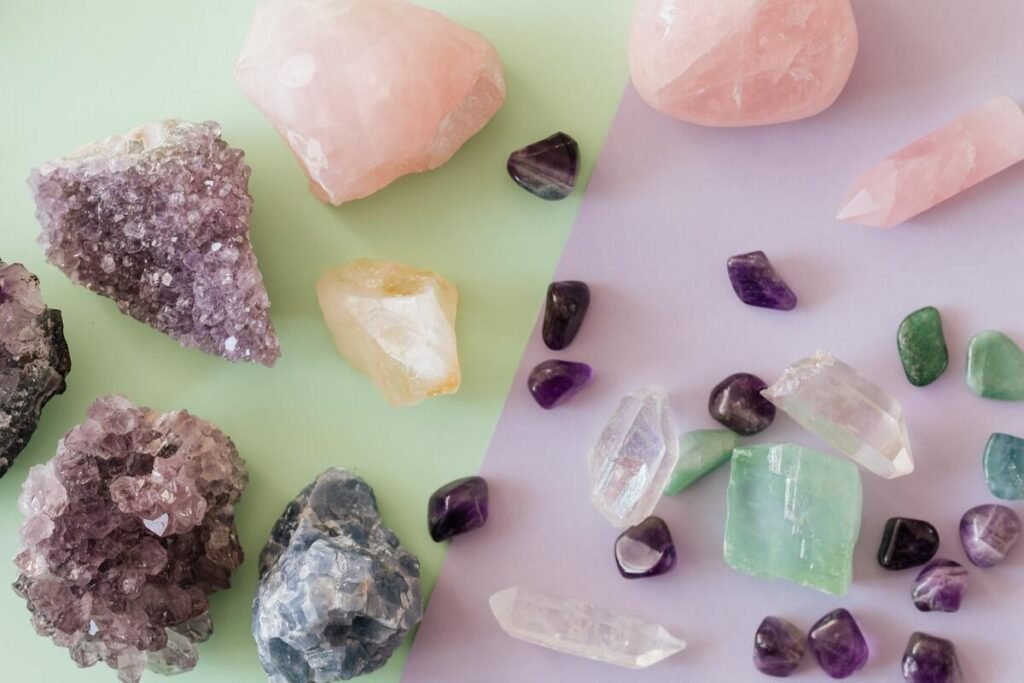
But this may be the most significant factor to consider since kunzites are usually clear, have bigger carat sizes to choose from, and can be cut to a good sparkle by skilled gemstone cutters due to its fairly malleable hardness.
Sugilite
More than its purple color, what makes the sugilite even more attractive is the varying pattern of colors on its surface. This stone is considered to be quite a rare one, having been discovered in Japan and only in a few places outside of it.
Beyond jewelry, the sugilite is perfect for meditation. It carries one of the more wonderful purple gemstones and meanings because of its spiritual qualities. In terms of health, the sugulite has been linked to the waking of the crown chakra. It also helps in combating mental stress, making it a great gem to offer hope and encouragement in trying times.
Tanzanite
Similar to the iolite, the tanzanite usually appears blue as seen and sold in the market. However, its purple variant is also a big hit among jewelry enthusiasts, considering that it has only been discovered in 1967. Those born in December know that it’s quite an iconic gem due to its sparkly finish. The deep blue variety can even be a good alternative to the rich blue of the sapphire stone, just like the one in this Gordon’s Jewelers review.
However, this is another one of the pricier stones, if you go for the natural kind. Since it was discovered in Tanzania, it is usually mined within a certain area at the base of Mount Kilimanjaro.
Are Purple Stones Valuable?
Some of the purple gemstones on the list can be more affordable, such as the amethyst. However, there are also a number of rare purple gemstones that may hold a higher price tag and value in the market. For instance, the sugilite is a fairly rare gem, especially with only a few areas in Japan where small deposits can be mined.
Its unique patterns of patches make it stand out among the choices. However, compared to other purple gemstones, the sugilite is not the most durable. It can be easily damaged, which does not make it suitable for everyday wear.
When dealing with purple stones, make sure you ask your jeweler about ways that you can protect the stone. Some may recommend finding a good, suitable setting type to encase the gemstone securely on the ring. Others may need to settle with wearing the stone on their person in other ways, so as not to damage them further.
What is the most expensive purple stone?
As with all jewelry, the price tag will factor in a lot of standards and considerations. Apart from the 4Cs—clarity, color, carat, and cut—you also have to consider rarity. Purple gemstones, especially the naturally-occurring ones, can be harder to find.
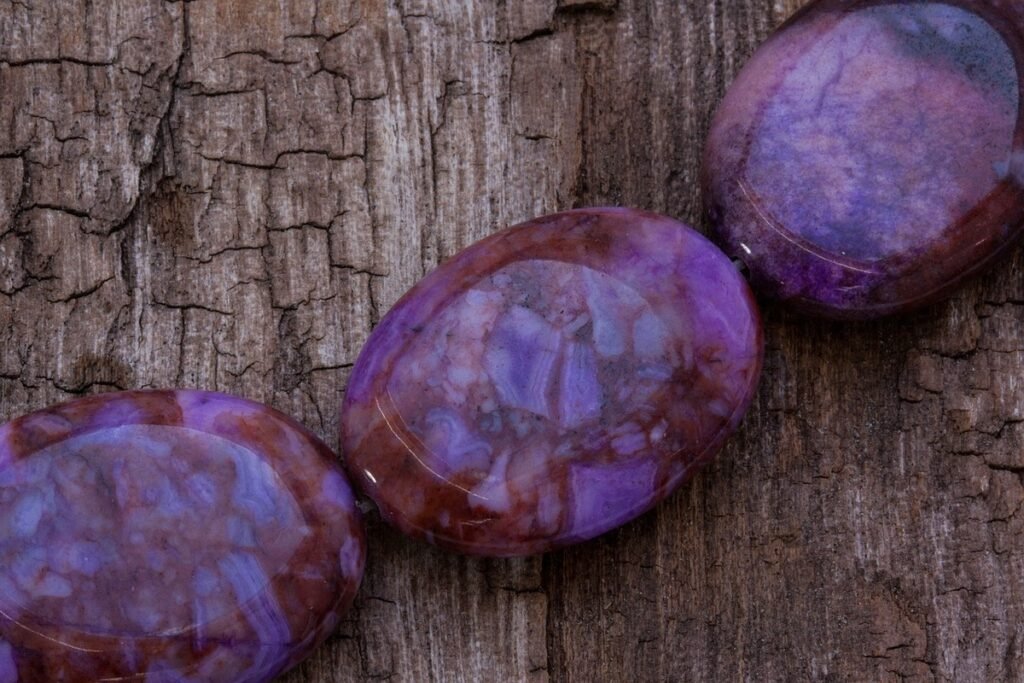
Some stones like the purple diamond, alexandrite, and sugilite are harder to find on the market. Yet they can also be the more preferred stones for jewelry because of their unique properties and qualities.
If you are on a budget, the most common and accessible purple gemstones include amethyst and kunzite.
Synthetic purple gemstones
However, if there are certain gemstone types that you just need to have, going for the synthetic variant is still a fairly reasonable option. For instance, the market already carries a lot of synthetic alexandrite stones because they are so hard to find.
If you are a first-time buyer, it is good to remember that synthetic does not have to be an issue when buying jewelry. Synthetic gems usually contain a similar composition as the naturally-occurring variants. The only difference is that these diamonds are grown in labs under controlled conditions, rather than being mined out of the earth.
Thus, if you want an alexandrite but can only afford to get one of the synthetic variety, then you do not have to worry about losing some of its characteristics. A synthetic alexandrite will still change color depending on light exposure.
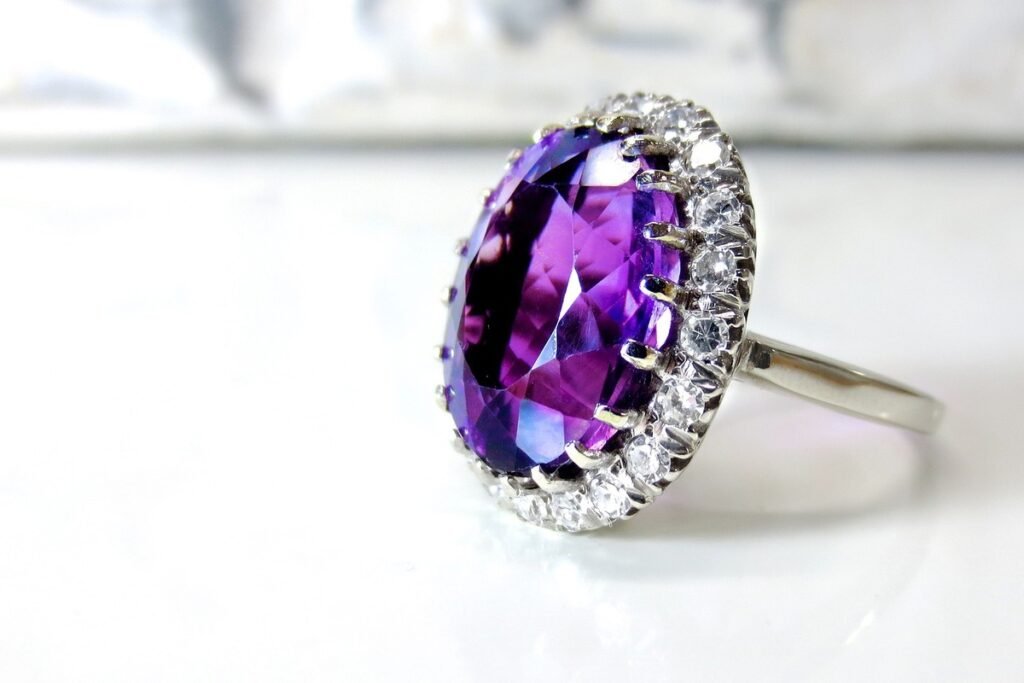
The same goes for the Tanzanite. The market usually carries only synthetic Tanzanite because of its rarity. Additionally, the heat-treated Tanzanite usually has richer hues due to its manufacturing process, similar to the one in this Fink engagement ring review.
Choosing purple gems
There are a lot of reasons to choose purple gemstones. The color alone already holds a regal aesthetic. Not to mention that the rarity of these stones surpass others of the primary color variety. Combine this with the meanings of wisdom, spirituality, fulfillment, and dignity, and you have a beautiful piece of jewelry that should hold a special place in your collection.
If you want to know more about other diamond alternatives besides a purple gemstone, read our article, “The Other Stones: Top Five Diamond Alternatives That Don’t Break The Bank.”
